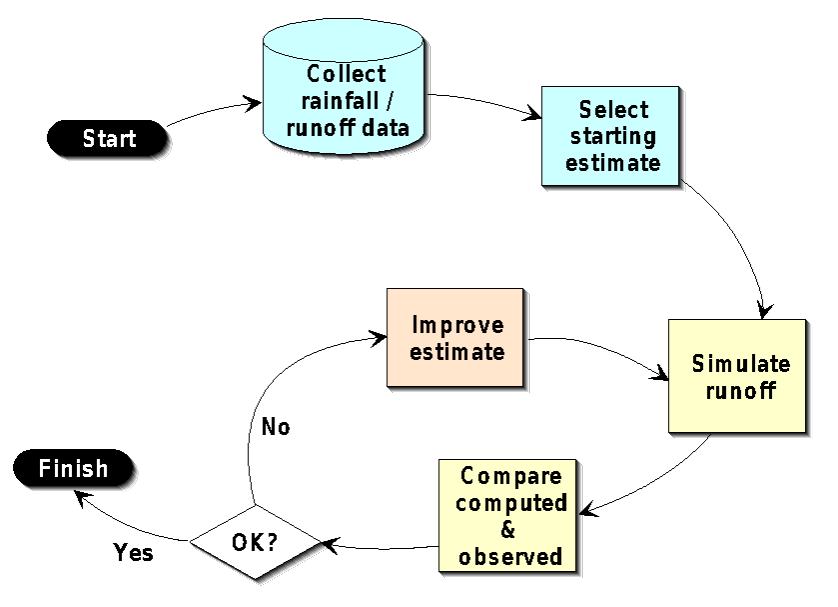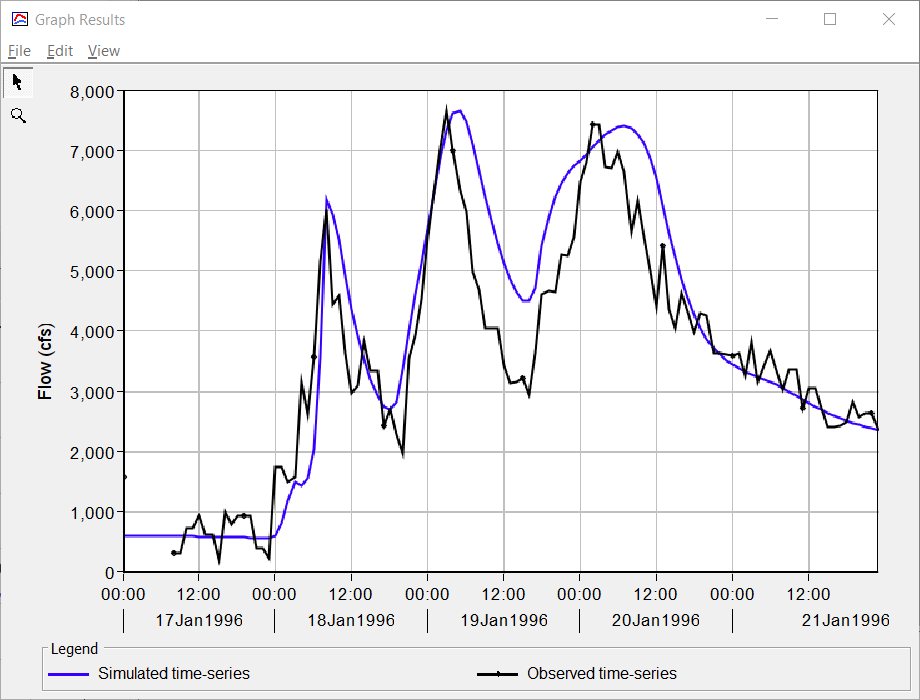Download PDF
Download page Summary of the Calibration Procedure.
Summary of the Calibration Procedure
In HEC-HMS, the systematic search for the best (optimal) parameter values follows the procedure illustrated in the Figure below. 
This procedure begins with data collection. For rainfall-runoff models, the required data are rainfall and flow time series. For routing models, observations of both inflow to and outflow from the routing reach are required. The two tables below offer some tips for collecting these data.
Table. Tips for collecting data for rainfall-runoff model calibration.
Rainfall and runoff observations must be from the same storm. The runoff time series should represent all runoff due to the selected rainfall time series. |
The rainfall data must provide adequate spatial coverage of the watershed, as these data will be used with the methods described in this manual to compute Mean Areal Precipitation (MAP) for the storm. |
The volume of the runoff hydrograph should approximately equal the volume of the rainfall hyetograph. If the runoff volume is slightly less, water is being lost to infiltration, as expected. But if the runoff volume is significantly less, this may indicate that flow is stored in natural or engineered ponds, or that water is diverted out of the stream. Similarly, if the runoff volume is slightly greater, baseflow is contributing to the total flow, as expected. However, if the runoff volume is much greater, this may indicate that flow is entering the system from other sources, or that the rainfall was not measured accurately. |
The duration of the rainfall should exceed the time of concentration of the watershed to ensure that the entire watershed upstream of the concentration point is contributing to the observed runoff. |
The size of the storm selected for calibration should approximately equal the size of the storm the calibrated model is intended to analyze. For example, if the goal is to predict runoff from a 1%-chance 24-hour storm of depth 7 inches, data from a storm of duration approximately 24 hours and depth approximately 7 inches should be used for calibration. |
Table. Tips for collecting data for routing model calibration.
The upstream and downstream hydrograph time series must represent flow for the same period of time. |
The volume of the upstream hydrograph should approximately equal the volume of the downstream hydrograph, with minimum lateral inflow. The lumped routing models in HEC-HMS assume that these volumes are equal. |
The duration of the downstream hydrograph should be sufficiently long so that the total volume represented equals the volume of the upstream hydrograph. |
The size of the event selected for calibration should approximately equal the size of the event the calibrated model is intended to analyze. For example, if the study requires prediction of downstream flows for an event with depths of 20 feet in a channel, historical data for a event of similar depth should be used for calibration. |
The next step is to select initial estimates of the parameters. As with any search, the better these initial estimates (the starting point of the search), the quicker the search will yield a solution. Tips for parameter estimation found in previous sections may be useful here.
Given these initial estimates of the parameters, the models included in the program can be used with the observed boundary conditions (rainfall or upstream flow and meteorological conditions) to compute the output, either the watershed runoff hydrograph or a channel outflow hydrograph. At this point, the program compares the computed hydrograph to the observed hydrograph. For example, it computes the hydrograph represented with the dashed line in the Figure below and compares it to the observed hydrograph represented with the solid line. Visual inspection is an important first step - the modeler should try to reproduce observed peaks, timing, and volume. The goal of this comparison is to judge how well the model "fits" the real hydrologic system.

The objective of calibration is to minimize the difference between simulated values and observed (measured) values. Statistical methods are used to quantify how simulated values compare to observed values. Statistical indices used to evaluate how well the model fits the observed data are discussed in the Calibration Summary Statistics section. In manual calibration, the modeler iteratively adjusts the parameters to achieve an acceptable fit. In automated calibration, if the fit is not satisfactory, the program systematically adjusts the parameters and reiterates. The algorithms used in the automatic adjustment of the parameters are described in the Optimization section. When the fit is satisfactory, the modeler retains the optimal parameter values. The presumption is that these parameter values then can be used for runoff or routing computations that are the goal of the flood runoff analyses. It is important to validate the model after it has been calibrated by running it with data that was not used for calibration.
You can follow along a step-by-step calibration process in several tutorials available here: Ideas and Workflows for Calibrating HEC-HMS Models